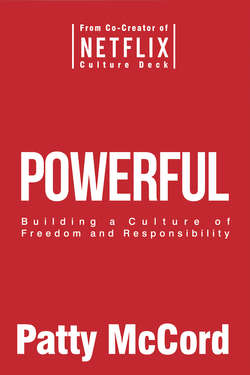Читать книгу Powerful - Patty McCord - Страница 7
На сайте Литреса книга снята с продажи.
People Have Power; Don’t Take It Away
ОглавлениеThe first step in adopting the practices I’ll present is embracing a management mind-set that overturns conventional wisdom.
The fundamental lesson we learned at Netflix about success in business today is this: the elaborate, cumbersome system for managing people that was developed over the course of the twentieth century is just not up to the challenges companies face in the twenty-first. Reed Hastings and I and the rest of the management team decided that, over time, we would explore a radical new way to manage people—a way that would allow them to exercise their full powers.
We wanted all of our people to challenge us, and one another, vigorously. We wanted them to speak up about ideas and problems; to freely push back, in front of one another and in front of us. We didn’t want anyone, at any level, keeping vital insights and concerns to themselves. The executive team modeled this: We made ourselves accessible, and we encouraged questions. We engaged in open, intense debate and made sure all of our managers knew we wanted them to do the same. Reed even staged debates between members of the executive team. We also communicated honestly and continuously about challenges the company was facing and how we were going to tackle them. We wanted everyone to understand that change would be a constant and that we would make whatever changes of plan, and of personnel, we thought necessary to forge ahead at high speed. We wanted people to embrace the need for change and be thrilled to drive it. We had come to understand that the most successful organizations in this world of increasingly rapid disruption will be the ones in which everyone, on every team, understands that all bets are off and everything is changing—and thinks that’s great.
To build that kind of company, we were intent on creating a culture of great teamwork and innovative problem solving. We wanted people to feel excited to come to work each day, not despite the challenges but because of them. I’m not going to say that working at Netflix wasn’t often extremely hair-raising. Some of the decisions we had to make were radical plunges into the unknown, and that was often truly scary. But it was also exhilarating.
The Netflix culture wasn’t built by developing an elaborate new system for managing people; we did the opposite. We kept stripping away policies and procedures. We realized that the prevailing approach to building teams and managing people is as outdated as product innovation was before the quickening pace of disruption demanded the development of agile, lean, and customer-centric methods. It’s not that companies aren’t trying all kinds of things to manage better; but most of what they’re doing is either beside the point or counterproductive.
Most companies are clinging to the established command-and-control system of top-down decision making but trying to jazz it up by fostering “employee engagement” and by “empowering” people. Compelling but misguided ideas about “best practices” prevail: bonuses and pay tied to annual performance reviews; big HR initiatives like the recent craze for lifelong learning programs; celebrations to build camaraderie and make sure people have some fun; and, for employees who are struggling, performance improvement plans. These foster empowerment, and with that comes engagement, which leads to job satisfaction and employee happiness, and that leads to high performance, or so the thinking goes.
I used to believe this too. I started my career in HR at Sun Microsystems and then Borland Software, implementing the whole gamut of conventional practices. I negotiated all kinds of tantalizing bonuses. I dutifully rallied my teams for the dreaded performance review season and coached managers through the performance improvement process. When I ran diversity programs at Sun, I even spent $100,000 on a Cinco de Mayo party. But over time I saw that all of those policies and systems were enormously costly, time-consuming, and unproductive. Even more important, I saw that they were premised on false assumptions about human beings: that most people must be incentivized in order to really throw themselves into their work, and that they need to be told what to do. The “best practices” that have been developed on the basis of these premises are, ironically, disincentivizing and disempowering.
Yes, engaged employees probably deliver higher-quality performance, but too often engagement is treated as the endgame, rather than serving customers and getting results. And the standard beliefs about how and why people are engaged in their work miss the true drivers of work passion. As for empowerment, I simply hate that word. The idea is well intentioned, but the truth is that there is so much concern about empowering people only because the prevailing way of managing them takes their power away. We didn’t set out to take it away; we just overprocessed everything. We’ve hamstrung people.
What I came to understand deeply and in a new way once I made my way into the scrappier start-up world is that people have power. A company’s job isn’t to empower people; it’s to remind people that they walk in the door with power and to create the conditions for them to exercise it. Do that, and you will be astonished by the great work they will do for you.
